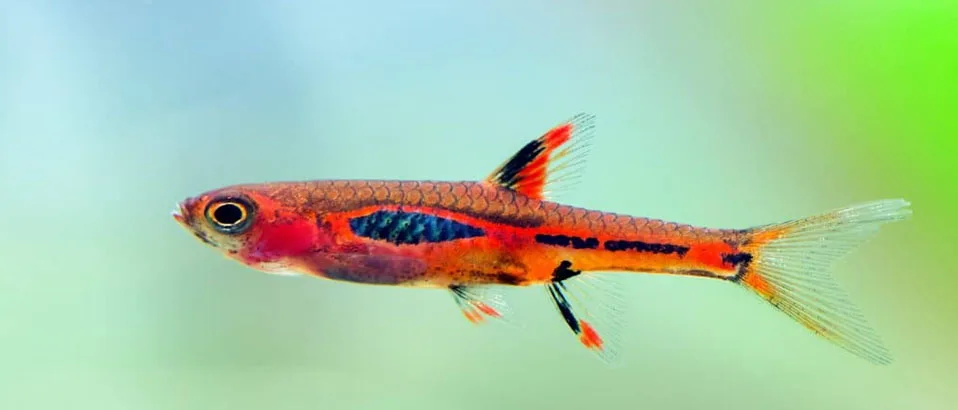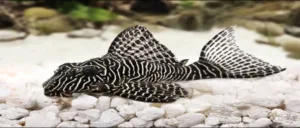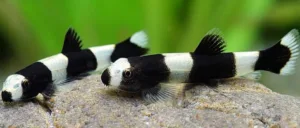The Chili Rasbora, scientifically known as Boraras brigittae, is a petite, vibrantly colored fish that has captivated the hearts of aquarium enthusiasts worldwide. They originate from the dense, acidic waters of Southeast Asia. Chili Rasboras offer a lively burst of color to any freshwater setup, making them particularly beloved in the realm of nano aquariums.
Natural Habitat of Chili Rasbora
In the wild, Chili Rasboras inhabit the peat swamp forests of Indonesia, thriving in dark, acidic waters. This environment is crucial to their survival, offering abundant cover and a diet rich in microorganisms.
Chili Rasbora Size
Chili Rasboras are perfect for small tanks, allowing aquarists to enjoy their vibrant colors in more compact spaces. Typically, an adult Chili Rasbora reaches a size of only about 0.8 to 1.2 inches (2 to 3 centimeters) in length. This petite size classifies them among the nano fish, a group of small fish that are ideal for nano aquarium setups.
The small size of Chili Rasboras means that their presence in an aquarium can be less biologically demanding compared to larger fish. It allows for a higher number of individuals to be comfortably housed in a relatively small volume of water, thus enabling fish keepers to create visually stunning displays of schooling behavior without requiring a large footprint. Moreover, their size makes them a perfect choice for intricate aquascapes where every inch of space counts, allowing for detailed and densely planted designs that mimic their natural habitats.
Additionally, their small size should be considered when thinking about tank mates and aquarium conditions. Being so small, they are not suited to cohabit with large or aggressive fish, as they can easily become stressed or preyed upon. Instead, they thrive in peaceful community tanks with other small, non-aggressive species that share similar water requirements.
Overall, the charm of the Chili Rasbora lies not only in its vivid coloration but also in its compact size, which offers versatility and ease of care, making it a beloved species among both novice and seasoned aquarists looking to add a touch of dynamism and color to their miniature aquatic worlds.
Breeding Chili Rasboras
Breeding Chili Rasboras can be a gratifying experience for aquarists, especially those interested in the nuances of raising nano fish. These small, vibrant creatures require specific conditions to successfully spawn and rear their offspring in captivity, highlighting the need for attention to detail and careful planning.
Creating the Right Environment
The first step in breeding Chili Rasboras is to set up a breeding tank that mimics their natural habitat as closely as possible. This environment typically involves soft, acidic water with a pH ranging from 4.0 to 6.5 and temperatures between 76 to 82 degrees Fahrenheit (24 to 28 degrees Celsius). The breeding tank should also be dimly lit and contain plenty of plant cover, such as Java moss or spawning mops, which not only provides shelter but also serves as a substrate for egg deposition.
Conditioning the Breeders
Prior to breeding Chili Rasboras, it’s crucial to condition the adults with high-quality food. A diet rich in live foods like micro worms, brine shrimp, and daphnia helps enhance their coloration and vigor, increasing the likelihood of successful spawning. This conditioning period typically lasts a few weeks, during which the fish should be closely monitored for signs of readiness, such as more vibrant colors and increased activity.
Spawning Process
Chili Rasboras are known for their subtle spawning cues. The actual spawning often occurs early in the morning and can be easy to miss. During spawning, the female lays a small number of eggs, usually between 6 to 30, which she carefully attaches to the underside of leaves or other submerged surfaces. The males will then fertilize the eggs externally. Given their shy nature, it’s often beneficial to either remove other tank inhabitants during this process or provide ample hiding spots to reduce stress.
Post-Spawning Care
After spawning, it’s advisable to remove the adult fish from the breeding tank to prevent them from eating the eggs or fry. The eggs will typically hatch within 24 to 36 hours, depending on the temperature. The fry are incredibly small and require infusoria or other micro-foods initially, as they are too tiny to consume the foods adult rasboras eat. As they grow, they can gradually be introduced to larger food.
Challenges and Tips
Breeding Chili Rasboras does come with its challenges. Their small size and the minuscule nature of their fry make them particularly vulnerable to water quality issues. Regular, gentle water changes and meticulous maintenance are crucial to ensure the survival of the fry. Additionally, breeding these fish requires patience and attention to detail, from the setup of the breeding environment to the care of the fry.
Successful breeding not only contributes to the preservation of this species in aquariums but also offers aquarists the rewarding experience of observing the complete life cycle of these captivating fish. Through careful planning and consistent care, aquarists can enjoy the emergence of new generations of Chili Rasboras, adding depth and enrichment to their hobby.
Chili Rasbora Male vs Female
Distinguishing between male and female Chili Rasboras can be incredibly helpful for aquarists. Here is a detailed table outlining the key differences:
| Feature | Male Chili Rasbora | Female Chili Rasbora |
|---|---|---|
| Coloration | Brighter and more vivid colors; often a deeper red along the body. | Generally paler with a more subdued red hue. |
| Size | Slightly smaller and slimmer compared to females. | Typically larger and fuller-bodied, especially when gravid (carrying eggs). |
| Behavior | More active and may display more prominently during courtship displays. | Tends to be less bold, more reserved. |
| Fin Shape | The fins, especially the dorsal and anal fins, are often more pointed. | Fins are usually rounder and less pronounced. |
| Body Shape | Streamlined and slender, making them appear more linear. | Broader in the midsection due to their role in egg production. |
The table above, highlights the primary physical and behavioral differences between male and female Chili Rasboras, aiding in their identification and management in an aquarium setting. Recognizing these differences is particularly important during breeding or when observing social interactions within the tank.
Aquarium Requirements
Chili Rasboras are quintessential schooling fish, displaying an intricate social structure that is both a survival mechanism and a captivating natural spectacle. They prefer the company of their own kind, often seen darting through water in harmonious unison.
Chili Rasbora Tank Size
Chili Rasboras are ideal candidates for nano aquariums due to their small size and modest space requirements. For these miniature fish, a minimum tank size of 5 gallons is often recommended. However, considering their schooling nature and the biological and social benefits of keeping them in groups, a larger tank (such as a 10 or 20 gallon setup) can be more suitable and visually appealing. Larger tanks not only provide more space for the fish to exhibit natural behaviors and interact, but they also allow for more stable water conditions, which is crucial for the health of these sensitive species. Adequate space ensures that each fish can thrive without the stress of overcrowding, promoting a healthier and more dynamic environment.
How Many Chili Rasbora in a 5 Gallon?
In a 5-gallon tank, it is advisable to start with a small school of about 6 to 8 Chili Rasboras. This number allows for adequate schooling behavior without overcrowding the tank. Keeping them in groups is essential as it enhances their coloration and activity levels, making the tank more lively and aesthetically pleasing. However, it’s important to monitor water quality closely, as smaller volumes are more prone to rapid changes in parameters, which can stress or harm these delicate fish.
Chili Rasbora Water Parameters
Chili Rasboras thrive in water conditions that mimic their natural habitat in the peat swamp forests of Southeast Asia. The ideal water parameters for maintaining healthy Chili Rasboras are:
- Temperature: The water temperature for Chili Rasboras should be maintained between 68°F and 82°F (20°C to 28°C). They prefer the warmer end of this spectrum.
- pH Level: The pH should be acidic, ideally between 4.0 and 7.0, with the optimal range being closer to 6.0 or slightly below.
- Water Hardness: They require soft water, with a general hardness (GH) of 1-10 dGH and a carbonate hardness (KH) below 5 dKH.
Maintaining these parameters requires regular testing and adjustments to ensure the water remains within the suitable range for these sensitive fish.
Chili Rasbora Tank Mates
When selecting tank mates for Chili Rasboras, it’s important to choose other peaceful, small species that thrive in similar conditions. Suitable companions include:
- Other Rasboras: Smaller rasboras like the Dwarf Rasbora or Mosquito Rasbora.
- Dwarf Shrimp: Such as Cherry Shrimp or Crystal Red Shrimp, which are not only compatible but also add to the biodiversity of the tank.
- Other Micro Fish: Such as Pygmy Corydoras or small Tetras like Neon Tetras, provided the water parameters are closely matched.
Avoid larger, aggressive fish that may intimidate or harm these small rasboras. The key is to maintain a harmonious environment that supports the well-being of all inhabitants, emphasizing the need for similar water parameters and behavioral compatibility.
Aquascaping for Chili Rasbora
Creating a miniature ecosystem that resembles their natural habitat involves incorporating dense vegetation such as Java moss or Anubias, along with a dark substrate to highlight their vivid coloration. Strategic placement of driftwood and leaf litter not only enhances the aesthetic appeal but also supports their well-being by simulating a natural environment.
Chili Rasbora Care
Caring for Chili Rasboras involves a combination of maintaining proper water conditions, providing a suitable diet, and creating a stress-free environment conducive to their natural behaviors. Here’s a comprehensive guide to ensuring these vibrant nano fish thrive in your aquarium:
Acclimation Process
Introducing Chili Rasboras to a new aquarium requires patience. Gradually acclimate them to tank conditions by using the drip method over several hours to avoid shock. Quarantining new arrivals for a few weeks can prevent the spread of diseases to established residents.
Optimal Water Conditions
Achieving and maintaining the right water conditions is paramount for the health of Chili Rasboras. They require soft, slightly acidic water with a pH between 4.0 and 7.0 and temperatures ranging from 68°F to 82°F (20°C to 28°C). Regular monitoring of water parameters is crucial, as fluctuations in pH, temperature, and toxin levels (such as ammonia, nitrite, and nitrate) can be particularly harmful to these small fish.
Tank Setup
Chili Rasboras flourish in tanks that replicate their natural habitat, which includes plenty of plants and a dark substrate. Plants not only provide shelter and security but also assist in maintaining water quality. Floating plants can be particularly beneficial as they diffuse lighting, which mimics the shaded waters of their natural environment, making the rasboras feel more secure and less stressed.
Social Structure
Being a schooling fish, Chili Rasboras should be kept in groups of at least 6 to 10 individuals. This not only enhances their natural coloration and activity levels but also helps reduce stress. Watching a school of Chili Rasboras move in unison through a well-planted tank can be a truly mesmerizing sight.
Regular Maintenance
To keep your Chili Rasboras healthy, regular tank maintenance is a must. This includes routine water changes of 10-25% per week, depending on the tank size and bioload. Substrate should be gently vacuumed during water changes to remove food debris and waste. Filters should also be cleaned regularly, but care should be taken not to disrupt the beneficial bacteria essential for a healthy aquarium.
Health Monitoring
Regularly observe your Chili Rasboras for signs of stress or illness, such as lack of activity, clamped fins, or fading colors. Early detection of problems allows for quicker intervention, which can be critical for their recovery. Ensure that any medications used are safe for such small and delicate fish.
Proper care of Chili Rasboras involves a delicate balance of detailed attention and consistent maintenance, but the rewards of maintaining these vibrant little jewels are well worth the effort. They can transform any aquarium with their lively demeanor and striking color, making them a favorite among aquarists who appreciate the beauty and dynamics of nano fish.
Chili Rasbora Lifespan
Chili Rasboras are known not only for their vibrant color and small size but also for their relatively long lifespan, especially when compared to other nano fish species. Under optimal care conditions, Chili Rasboras can live for up to 4 to 5 years.
Like many species, the lifespan of Chili Rasboras can be influenced by their genetic makeup, diet and care which determines their resilience to diseases and environmental stress. Fish from a healthy, robust genetic line are more likely to reach the upper end of their lifespan potential.
Food Requirements
Chili Rasboras require a specific diet to maintain their health and coloration. Their nutritional needs are not overly complex, but attention to quality and variety is crucial to ensure these small fish thrive in captivity.
Basic Dietary Needs
Chili Rasboras are omnivorous in nature, but their diet leans heavily towards small invertebrates and zooplankton in the wild. In the aquarium setting, it’s essential to mimic this natural diet to some extent to maintain their health and vitality.
Types of Food
- Micro Pellets: These are an excellent staple for Chili Rasboras due to their small size and high nutrient content. Pellets formulated specifically for small tropical fish typically contain a balanced mix of protein, fats, and essential vitamins.
- Live Foods: To closely replicate their natural eating habits, live foods such as daphnia, brine shrimp nauplii, and micro worms are ideal. Live foods not only provide high-quality protein but also encourage natural foraging behaviors and help in enhancing the fish’s coloration.
- Frozen Foods: Frozen varieties of the above-mentioned live foods are also suitable and can be more convenient while still providing essential nutrients. However, it’s crucial to ensure that the food is thoroughly thawed before feeding.
- Insect Larvae: Small insect larvae, like mosquito larvae, are a natural food source for Chili Rasboras in the wild and can be offered in the aquarium as well. These should be provided sparingly due to their size.
- Vegetable Matter: While not a significant part of their diet, incorporating some vegetable matter such as finely chopped spinach or zucchini can provide additional vitamins and minerals.
Feeding Practices
- Frequency: Chili Rasboras should be fed small amounts multiple times a day—typically two to three times daily. This method mimics their natural feeding habits and prevents overfeeding, which can lead to water quality issues.
- Quantity: Each feeding session should last about 1-2 minutes, and only the amount they can consume in this time should be offered. Excess food can decay and pollute the tank, leading to poor water conditions that can stress the fish and lead to health problems.
- Diversity: Regularly rotating the types of food offered not only ensures a balanced diet but also keeps the fish engaged and active. A varied diet supports better immune function and overall health.
Special Considerations
Given their small mouths and the size of the aquarium they are typically kept in, it’s vital to choose foods that are small enough for them to ingest easily. Larger food particles that are not consumed can sink and decompose, negatively affecting the water quality.
Properly feeding Chili Rasboras is not just about sustaining them; it’s about enriching their environment and ensuring their longevity. A carefully considered diet enhances their vibrant coloration and supports their health, allowing these tiny fish to be active and lively members of the aquarium.
Phoenix Rasbora vs Chili Rasbora
The following table provides a clear overview of the similarities and differences between Phoenix Rasboras and Chili Rasboras, helping enthusiasts make informed decisions about which species might best suit their aquarium setup and personal preferences. Both species share many care requirements but differ notably in their coloration and subtle habitat preferences.
| Feature | Phoenix Rasbora (Boraras merah) | Chili Rasbora (Boraras brigittae) |
|---|---|---|
| Size | Typically around 0.8 to 1.2 inches in length. | Similar size, around 0.8 to 1.2 inches in length. |
| Coloration | Reddish-orange with a darker stripe from the mid-body to the tail. | Deeper red color with a black and gold stripe along the lateral line. |
| Behavior | Generally peaceful and shy; suitable for community tanks with small, non-aggressive species. | Also peaceful and schooling; thrives in groups and is similarly suitable for community tanks with small, gentle fish. |
| Habitat in the Wild | Found in peat swamp forests and streams with acidic water in parts of Southeast Asia. | Inhabits similar peat swamp environments, thriving in acidic, soft waters with a lot of vegetation. |
| Aquarium Requirements | Requires soft, acidic water with plenty of plant cover. Prefers subdued lighting and gentle water flow. | Very similar requirements: soft, acidic water, dense vegetation, and low to moderate light. |
| Diet | Feeds on small insects, larvae, and zooplankton. Prefers a diet of small live or frozen foods in captivity. | Eats a similar diet, with a preference for small live or frozen foods like daphnia, brine shrimp, and micro worms. |
| Breeding | Can be bred in captivity under the right conditions. Requires soft, acidic water and a diet rich in live foods to induce spawning. | Similar breeding requirements, with emphasis on water quality and temperature to successfully breed and rear fry. |
Ember Tetra vs Chili Rasbora
The following table should help in understanding the key distinctions and shared characteristics between Ember Tetras and Chili Rasboras, aiding aquarists in choosing the right fish for their tanks based on behavior, care requirements, and community compatibility. Both species are excellent choices for serene and visually appealing aquarium setups.
| Feature | Ember Tetra (Hyphessobrycon amandae) | Chili Rasbora (Boraras brigittae) |
|---|---|---|
| Size | Typically around 0.8 to 1 inch in length. | Similar size, around 0.8 to 1.2 inches in length. |
| Coloration | Bright orange or amber throughout the body. | Vibrant red with a black and gold lateral line. |
| Behavior | Peaceful and schooling; thrives in groups and is suited for community tanks with similar-sized and non-aggressive fish. | Also peaceful and schooling; requires being in groups to feel secure and exhibit natural behaviors. |
| Habitat in the Wild | Originates from the rivers of Brazil, preferring soft, acidic water conditions. | Found in the peat swamp forests of Southeast Asia, thriving in acidic, soft waters with dense vegetation. |
| Aquarium Requirements | Needs soft, slightly acidic to neutral water with good plant coverage and subdued lighting. | Similar needs with a preference for soft, acidic water, heavy plantation, and low to moderate light. |
| Diet | Omnivorous, requiring a varied diet of small granules, flakes, and live or frozen foods like brine shrimp and daphnia. | Primarily insectivorous, preferring live or frozen foods such as daphnia, brine shrimp, and micro worms. |
| Breeding | Can be bred in captivity; requires slightly warmer water and fine-leaved plants or a spawning mop for egg laying. | Similar breeding environment with a need for fine plant leaves or spawning mops, and very soft, acidic water for optimal breeding conditions. |
| Tank Mates | Suitable for community tanks with other peaceful small fish such as other tetras, small rasboras, and dwarf shrimp. | Best kept with other small, peaceful fish such as micro rasboras, small tetras, and non-predatory shrimp. |
Strawberry Rasbora vs Chili Rasbora
Here’s a comparative table between Strawberry Rasboras and Chili Rasboras, providing insights into their distinct characteristics and similarities. This comparison will help aquarium enthusiasts decide which species might be a better fit for their specific aquarium setup:
| Feature | Strawberry Rasbora (Boraras naevus) | Chili Rasbora (Boraras brigittae) |
|---|---|---|
| Size | Slightly larger, typically around 0.8 to 1.5 inches in length. | Smaller, usually about 0.8 to 1.2 inches in length. |
| Coloration | Pinkish body with darker spots and a more subdued overall hue. | Bright red to orange body with a distinctive black and gold lateral line. |
| Behavior | Peaceful and schooling; enjoys the company of its own kind and suitable for community tanks with gentle species. | Also peaceful and schooling; best kept in groups to enhance security and natural behavior. |
| Habitat in the Wild | Found in slow-moving waters and heavily vegetated marshes in Southeast Asia. | Inhabits peat swamp forests and similar soft, acidic water environments in Southeast Asia. |
| Aquarium Requirements | Prefers slightly acidic to neutral water, with a lot of plants for hiding. Needs clean, stable conditions. | Requires soft, acidic water with dense vegetation and low to moderate lighting. |
| Diet | Omnivorous; thrives on a diet of small insects, larvae, and prepared foods suitable for tiny fish. | Primarily insectivorous, with a preference for live or frozen foods such as daphnia, brine shrimp, and micro worms. |
| Breeding | Can be bred in similar conditions to Chili Rasboras, with soft, acidic water and plenty of plants for egg laying. | Breeds under specific conditions with soft, acidic water and requires fine-leaved plants or spawning mops for egg deposition. |
| Tank Mates | Does well with other small, peaceful fish and invertebrates that appreciate the same water conditions. | Also best kept with similar-sized, non-aggressive fish species and suitable for nano community aquariums. |
This table helps to highlight how Strawberry Rasboras and Chili Rasboras, while similar in many respects, offer subtle differences that might influence an aquarist’s choice depending on their preferences for coloration, size, and slight variations in care requirements. Both species are excellent for adding vibrant colors and dynamic schooling behavior to peaceful community tanks.
Myth vs. Reality
One common myth is that Chili Rasboras can thrive in unfiltered bowls or vases; however, they require a well-maintained aquarium with proper filtration and aeration to survive and flourish.
Cost of Ownership
While individual fish are relatively inexpensive, setting up and maintaining a suitable aquarium for Chili Rasboras can be a significant investment. Consider not only the initial setup costs but also ongoing expenses such as food, water conditioners, and equipment.
Conclusion
Chili Rasboras are a fascinating addition to any freshwater aquarium, offering a vibrant splash of color and activity. With proper care, these tiny treasures can thrive, providing aquarists with a delightful glimpse into the dynamic world of nano fishkeeping. Whether you’re a novice or an experienced hobbyist, the Chili Rasbora promises to enrich your aquatic experience with its beauty and lively demeanor.




